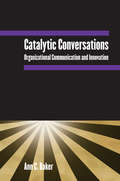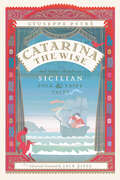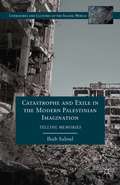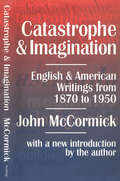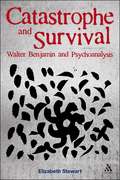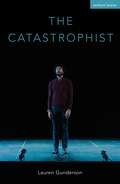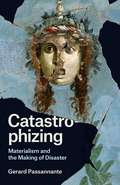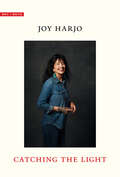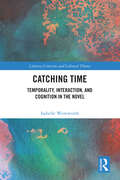- Table View
- List View
Catalytic Conversations: Organizational Communication and Innovation
by Ann C. BakerIn today's increasingly globalized world, it is essential that people of diverse ethnicities and socio-economic backgrounds learn to work together and communicate effectively. This book offers a breakthrough approach to recognizing that differences among people are resources for organizations to tap as they strive to anticipate change and adapt rapidly in an unpredictable world. "Catalytic Conversations" provides a conceptual framework for understanding how complex communication patterns of social networks influence, and are influenced by, organizational structures. It discusses how to enhance the quality and viability of groups and organizational life by paying attention to how people talk - and do not talk - to each other. The book distinguishes between conversations that support organizational enhancement and others that inhibit innovation, and explores the complexity of organizational communication in detail.
Catalytic Conversations: Organizational Communication and Innovation
by Ann C. BakerIn today's increasingly globalized world, it is essential that people of diverse ethnicities and socio-economic backgrounds learn to work together and communicate effectively. This book offers a breakthrough approach to recognizing that differences among people are resources for organizations to tap as they strive to anticipate change and adapt rapidly in an unpredictable world. "Catalytic Conversations" provides a conceptual framework for understanding how complex communication patterns of social networks influence, and are influenced by, organizational structures. It discusses how to enhance the quality and viability of groups and organizational life by paying attention to how people talk - and do not talk - to each other. The book distinguishes between conversations that support organizational enhancement and others that inhibit innovation, and explores the complexity of organizational communication in detail.
Catarina the Wise and Other Wondrous Sicilian Folk and Fairy Tales
by Giuseppe PitrèWell, gentlemen, here’s a tale that people have told time and again . . . . So begins the title story in this collection of fifty Sicilian folk and fairy tales edited and translated by noted folklore scholar Jack Zipes. But while some of the stories may sound as if they’ve been told time and again—such as variations on Cinderella and Puss in Boots—many will enchant English-language readers and storytellers for the first time. From “The Pot of Basil” to “The Talking Belly,” “The Little Mouse with the Stinky Tail” to “Peppi, Who Wandered out into the World,” the stories in Catarina the Wise range from simple tales of getting a new dress or something good to eat to fantastical plots for outwitting domineering husbands, rescuing impoverished fathers, or attracting wealthy suitors (frequently the Prince of Portugal). Many feature strong, clever women (usually daughters who become queen). Many are funny; many are wise. Some are very, very strange. As Zipes relates, the true story of their origins is as extraordinary as the tales themselves. Born to a poor family of sailors in Palermo, Giuseppe Pitrè would go on to serve with Garibaldi, become a traveling country doctor, and gather one of the most colossal collections of folk and fairy tales of the nineteenth century. But while his work as a folklorist rivaled that of the Brothers Grimm, Pitrè remains a relative unknown. Catarina the Wise highlights some of the most delectable stories at the heart of his collection. Featuring new, original illustrations, this book is a beautiful, charming treasure for any fan of story, storytelling, and heroines and heroes living happily ever after—sometimes.
Catarina the Wise and Other Wondrous Sicilian Folk and Fairy Tales
by Giuseppe PitrèWell, gentlemen, here’s a tale that people have told time and again . . . . So begins the title story in this collection of fifty Sicilian folk and fairy tales edited and translated by noted folklore scholar Jack Zipes. But while some of the stories may sound as if they’ve been told time and again—such as variations on Cinderella and Puss in Boots—many will enchant English-language readers and storytellers for the first time. From “The Pot of Basil” to “The Talking Belly,” “The Little Mouse with the Stinky Tail” to “Peppi, Who Wandered out into the World,” the stories in Catarina the Wise range from simple tales of getting a new dress or something good to eat to fantastical plots for outwitting domineering husbands, rescuing impoverished fathers, or attracting wealthy suitors (frequently the Prince of Portugal). Many feature strong, clever women (usually daughters who become queen). Many are funny; many are wise. Some are very, very strange. As Zipes relates, the true story of their origins is as extraordinary as the tales themselves. Born to a poor family of sailors in Palermo, Giuseppe Pitrè would go on to serve with Garibaldi, become a traveling country doctor, and gather one of the most colossal collections of folk and fairy tales of the nineteenth century. But while his work as a folklorist rivaled that of the Brothers Grimm, Pitrè remains a relative unknown. Catarina the Wise highlights some of the most delectable stories at the heart of his collection. Featuring new, original illustrations, this book is a beautiful, charming treasure for any fan of story, storytelling, and heroines and heroes living happily ever after—sometimes.
Catarina the Wise and Other Wondrous Sicilian Folk and Fairy Tales
by Giuseppe PitrèWell, gentlemen, here’s a tale that people have told time and again . . . . So begins the title story in this collection of fifty Sicilian folk and fairy tales edited and translated by noted folklore scholar Jack Zipes. But while some of the stories may sound as if they’ve been told time and again—such as variations on Cinderella and Puss in Boots—many will enchant English-language readers and storytellers for the first time. From “The Pot of Basil” to “The Talking Belly,” “The Little Mouse with the Stinky Tail” to “Peppi, Who Wandered out into the World,” the stories in Catarina the Wise range from simple tales of getting a new dress or something good to eat to fantastical plots for outwitting domineering husbands, rescuing impoverished fathers, or attracting wealthy suitors (frequently the Prince of Portugal). Many feature strong, clever women (usually daughters who become queen). Many are funny; many are wise. Some are very, very strange. As Zipes relates, the true story of their origins is as extraordinary as the tales themselves. Born to a poor family of sailors in Palermo, Giuseppe Pitrè would go on to serve with Garibaldi, become a traveling country doctor, and gather one of the most colossal collections of folk and fairy tales of the nineteenth century. But while his work as a folklorist rivaled that of the Brothers Grimm, Pitrè remains a relative unknown. Catarina the Wise highlights some of the most delectable stories at the heart of his collection. Featuring new, original illustrations, this book is a beautiful, charming treasure for any fan of story, storytelling, and heroines and heroes living happily ever after—sometimes.
Catarina the Wise and Other Wondrous Sicilian Folk and Fairy Tales
by Giuseppe PitrèWell, gentlemen, here’s a tale that people have told time and again . . . . So begins the title story in this collection of fifty Sicilian folk and fairy tales edited and translated by noted folklore scholar Jack Zipes. But while some of the stories may sound as if they’ve been told time and again—such as variations on Cinderella and Puss in Boots—many will enchant English-language readers and storytellers for the first time. From “The Pot of Basil” to “The Talking Belly,” “The Little Mouse with the Stinky Tail” to “Peppi, Who Wandered out into the World,” the stories in Catarina the Wise range from simple tales of getting a new dress or something good to eat to fantastical plots for outwitting domineering husbands, rescuing impoverished fathers, or attracting wealthy suitors (frequently the Prince of Portugal). Many feature strong, clever women (usually daughters who become queen). Many are funny; many are wise. Some are very, very strange. As Zipes relates, the true story of their origins is as extraordinary as the tales themselves. Born to a poor family of sailors in Palermo, Giuseppe Pitrè would go on to serve with Garibaldi, become a traveling country doctor, and gather one of the most colossal collections of folk and fairy tales of the nineteenth century. But while his work as a folklorist rivaled that of the Brothers Grimm, Pitrè remains a relative unknown. Catarina the Wise highlights some of the most delectable stories at the heart of his collection. Featuring new, original illustrations, this book is a beautiful, charming treasure for any fan of story, storytelling, and heroines and heroes living happily ever after—sometimes.
Catastrophe and Exile in the Modern Palestinian Imagination: Telling Memories (Literatures and Cultures of the Islamic World)
by I. SaloulCatastrophe and Exile in the Modern Palestinian Imagination explores the cultural memory of al-Nakba (1948 Israeli independence, or The Catastrophe as it is known in Palestine) and its significance to the modern Palestinian imagination. Ihab Saloul addresses central concepts to debates over identity such as nostalgia and trauma, notions of home and forced travel, and geopolitical continuity of loss of place. Through an integrated method of close narrative and discursive analysis of diverse literary texts, films, and personal narratives, this study offers an analytical account of the preservation of cultural optimism in the face of the ongoing catastrophe, as well as the ways in which aesthetics and politics intersect in contemporary Palestinian culture.
Catastrophe and Imagination: English and American Writings from 1870 to 1950
by John McCormickSince World War II critics have been predicting the decline of the novel. This book argues that the novel is not dead. Looking at American and English fiction it claims that the novel can not only change the possibilities of art, but also contribute to awareness of life's possibilities.
Catastrophe and Imagination: English and American Writings from 1870 to 1950
by John McCormickSince World War II critics have been predicting the decline of the novel. This book argues that the novel is not dead. Looking at American and English fiction it claims that the novel can not only change the possibilities of art, but also contribute to awareness of life's possibilities.
Catastrophe and Survival: Walter Benjamin And Psychoanalysis
by Elizabeth StewartThis book shows how Benjamin's thoughts regarding the individual's experience of the material world make significant contact with post-Freudian psychoanalytic theory.
Catastrophe and Survival: Walter Benjamin And Psychoanalysis
by Elizabeth StewartThis book shows how Benjamin's thoughts regarding the individual's experience of the material world make significant contact with post-Freudian psychoanalytic theory.
The Catastrophist (Modern Plays)
by Lauren GundersonHow do you plan for a catastrophe? Virologist Nathan Wolfe, named one of TIME's 100 Most Influential People in the World for his work tracking viral pandemic outbreaks, proposed pandemic insurance years before the novel coronavirus outbreak. No one bought it. Now, in a post-COVID world, we hear his story. A time-jumping tale based on the life and work of Nathan Wolfe (who also happens to be the playwright's husband). Though not a play about COVID19, it is a true story of a pandemic expert. An deep dive into the profundities of scientific exploration, the lengths one goes for love and family, the bracing truths of fatherhood and discovery, and the harrowing realities of facing your own mortality, The Catastrophist is a world premiere theatrical experience built of and for this moment in time.
The Catastrophist (Modern Plays)
by Lauren GundersonHow do you plan for a catastrophe? Virologist Nathan Wolfe, named one of TIME's 100 Most Influential People in the World for his work tracking viral pandemic outbreaks, proposed pandemic insurance years before the novel coronavirus outbreak. No one bought it. Now, in a post-COVID world, we hear his story. A time-jumping tale based on the life and work of Nathan Wolfe (who also happens to be the playwright's husband). Though not a play about COVID19, it is a true story of a pandemic expert. An deep dive into the profundities of scientific exploration, the lengths one goes for love and family, the bracing truths of fatherhood and discovery, and the harrowing realities of facing your own mortality, The Catastrophist is a world premiere theatrical experience built of and for this moment in time.
Catastrophizing: Materialism and the Making of Disaster
by Gerard PassannanteWhen we catastrophize, we think the worst. We make too much of too little, or something of nothing. Yet what looks simply like a bad habit, Gerard Passannante argues, was also a spur to some of the daring conceptual innovations and feats of imagination that defined the intellectual and cultural history of the early modern period. Reaching back to the time between the Renaissance and the Enlightenment, Passannante traces a history of catastrophizing through literary and philosophical encounters with materialism—the view that the world is composed of nothing but matter. As artists, poets, philosophers, and scholars pondered the physical causes and material stuff of the cosmos, they conjured up disasters out of thin air and responded as though to events that were befalling them. From Leonardo da Vinci’s imaginative experiments with nature’s destructive forces to the fevered fantasies of doomsday astrologers, from the self-fulfilling prophecies of Shakespeare’s tragic characters to the mental earthquakes that guided Kant toward his theory of the sublime, Passannante shows how and why the early moderns reached for disaster when they ventured beyond the limits of the sensible. He goes on to explore both the danger and the critical potential of thinking catastrophically in our own time.
Catastrophizing: Materialism and the Making of Disaster
by Gerard PassannanteWhen we catastrophize, we think the worst. We make too much of too little, or something of nothing. Yet what looks simply like a bad habit, Gerard Passannante argues, was also a spur to some of the daring conceptual innovations and feats of imagination that defined the intellectual and cultural history of the early modern period. Reaching back to the time between the Renaissance and the Enlightenment, Passannante traces a history of catastrophizing through literary and philosophical encounters with materialism—the view that the world is composed of nothing but matter. As artists, poets, philosophers, and scholars pondered the physical causes and material stuff of the cosmos, they conjured up disasters out of thin air and responded as though to events that were befalling them. From Leonardo da Vinci’s imaginative experiments with nature’s destructive forces to the fevered fantasies of doomsday astrologers, from the self-fulfilling prophecies of Shakespeare’s tragic characters to the mental earthquakes that guided Kant toward his theory of the sublime, Passannante shows how and why the early moderns reached for disaster when they ventured beyond the limits of the sensible. He goes on to explore both the danger and the critical potential of thinking catastrophically in our own time.
Catastrophizing: Materialism and the Making of Disaster
by Gerard PassannanteWhen we catastrophize, we think the worst. We make too much of too little, or something of nothing. Yet what looks simply like a bad habit, Gerard Passannante argues, was also a spur to some of the daring conceptual innovations and feats of imagination that defined the intellectual and cultural history of the early modern period. Reaching back to the time between the Renaissance and the Enlightenment, Passannante traces a history of catastrophizing through literary and philosophical encounters with materialism—the view that the world is composed of nothing but matter. As artists, poets, philosophers, and scholars pondered the physical causes and material stuff of the cosmos, they conjured up disasters out of thin air and responded as though to events that were befalling them. From Leonardo da Vinci’s imaginative experiments with nature’s destructive forces to the fevered fantasies of doomsday astrologers, from the self-fulfilling prophecies of Shakespeare’s tragic characters to the mental earthquakes that guided Kant toward his theory of the sublime, Passannante shows how and why the early moderns reached for disaster when they ventured beyond the limits of the sensible. He goes on to explore both the danger and the critical potential of thinking catastrophically in our own time.
Catastrophizing: Materialism and the Making of Disaster
by Gerard PassannanteWhen we catastrophize, we think the worst. We make too much of too little, or something of nothing. Yet what looks simply like a bad habit, Gerard Passannante argues, was also a spur to some of the daring conceptual innovations and feats of imagination that defined the intellectual and cultural history of the early modern period. Reaching back to the time between the Renaissance and the Enlightenment, Passannante traces a history of catastrophizing through literary and philosophical encounters with materialism—the view that the world is composed of nothing but matter. As artists, poets, philosophers, and scholars pondered the physical causes and material stuff of the cosmos, they conjured up disasters out of thin air and responded as though to events that were befalling them. From Leonardo da Vinci’s imaginative experiments with nature’s destructive forces to the fevered fantasies of doomsday astrologers, from the self-fulfilling prophecies of Shakespeare’s tragic characters to the mental earthquakes that guided Kant toward his theory of the sublime, Passannante shows how and why the early moderns reached for disaster when they ventured beyond the limits of the sensible. He goes on to explore both the danger and the critical potential of thinking catastrophically in our own time.
Catch of the Day: Rhys Davies Short Story Collection 2014
by Literature WalesAn anthology of nine winning short stories from this highly regarded competition which has run since 1991 and celebrates contemporary Welsh writing in English. It also includes the winner and runner-up from the inaugural Under-21 Prize.The stories range widely in time and place - from Wales to Sweden and from the First World War to the present day - but all of them are rich in a sense of 'human-ness' and contain as Rhys Davies described a 'tiny, concentrated explosion' that makes you re-evaluate your life and yourself. Together they help to answer the question 'what makes a good story?' The title of the anthology, Catch of the Day, is taken from the winning entry, which deals with the question of loss and bereavement with a subtle and unexpected twist.
Catch That Chicken!: Targeting the ch Sound (Speech Bubbles 2)
by Melissa PalmerArchie has stolen Charlie’s prize hat – the race is on to get it back. Catch that chicken! This picture book targets the /ch/ sound and is part of Speech Bubbles 2, a series of picture books that target specific speech sounds within the story. The series can be used for children receiving speech therapy, for children who have a speech sound delay/disorder, or simply as an activity for children’s speech sound development and/or phonological awareness. They are ideal for use by parents, teachers or caregivers. Bright pictures and a fun story create an engaging activity perfect for sound awareness. Picture books are sold individually, or in a pack. There are currently two packs available – Speech Bubbles 1 and Speech Bubbles 2. Please see further titles in the series for stories targeting other speech sounds.
Catch That Chicken!: Targeting the ch Sound (Speech Bubbles 2)
by Melissa PalmerArchie has stolen Charlie’s prize hat – the race is on to get it back. Catch that chicken! This picture book targets the /ch/ sound and is part of Speech Bubbles 2, a series of picture books that target specific speech sounds within the story. The series can be used for children receiving speech therapy, for children who have a speech sound delay/disorder, or simply as an activity for children’s speech sound development and/or phonological awareness. They are ideal for use by parents, teachers or caregivers. Bright pictures and a fun story create an engaging activity perfect for sound awareness. Picture books are sold individually, or in a pack. There are currently two packs available – Speech Bubbles 1 and Speech Bubbles 2. Please see further titles in the series for stories targeting other speech sounds.
Catching Readers Before They Fall: Supporting Readers Who Struggle, K-4
by Pat Johnson Katie KeierEvery teacher of reading plays a vital role in helping to catch those readers for whom learning to read does not come easily. Through examples from both adults and children, the authors explain and describe the complex integrated network of strategies that go on in the minds of proficient readersstrategies that struggling readers have to learn in order to construct their own reading processes. This book is essential reading for all who work with struggling readers in any context and contains a wealth of resources, including a thorough explanation of all the sources of information readers use to solve words, examples and scenarios of teacher/student interactions, prompts to use with struggling readers, lessons on modeling, and assessment guidelines.
Catching Readers Before They Fall: Supporting Readers Who Struggle, K-4
by Pat Johnson Katie KeierEvery teacher of reading plays a vital role in helping to catch those readers for whom learning to read does not come easily. Through examples from both adults and children, the authors explain and describe the complex integrated network of strategies that go on in the minds of proficient readersstrategies that struggling readers have to learn in order to construct their own reading processes. This book is essential reading for all who work with struggling readers in any context and contains a wealth of resources, including a thorough explanation of all the sources of information readers use to solve words, examples and scenarios of teacher/student interactions, prompts to use with struggling readers, lessons on modeling, and assessment guidelines.
Catching the Light (Why I Write)
by Joy HarjoUnited States Poet Laureate and winner of the 2022 Academy of American Poets Leadership Award Joy Harjo examines the power of words and how poetry summons us toward justice and healing “Her enduring message—that writing can be redemptive—resonates: ‘To write is to make a mark in the world, to assert “I am.”’ The result is a rousing testament to the power of storytelling.”—Publishers Weekly “Harjo writes as if the creative journey has been the destination all along.”—Kirkus Reviews In this lyrical meditation about the why of writing poetry, Joy Harjo reflects on significant points of illumination, experience, and questioning from her fifty years as a poet. Comprised of intimate vignettes that take us through the author’s life journey as a youth in the late 1960s, a single mother, and a champion of Native nations, this book offers a fresh understanding of how poetry functions as an expression of purpose, spirit, community, and memory. Harjo insists the most meaningful poetry is birthed through cracks in history from what is broken and unseen. At the crossroads of this brokenness, she calls us to watch and listen for the songs of justice for all those America has denied. This is an homage to the power of words to defy erasure—to inscribe the story, again and again, of who we have been, who we are, and who we can be.
Catching Time: Temporality, Interaction, and Cognition (Literary Criticism and Cultural Theory)
by Isabelle Wentworth'Time travels in divers paces with divers people.' Shakespeare’s oft-quoted line contains a hidden ambiguity: not only do individual people experience time differently, but time travels in diverse paces when we are with diverse persons. The line articulates a contemporary understanding of subjective time: it is changed by interaction with our social environment. Interacting with other people—and even literary characters—can slow or quicken the experience of time. Interactive time, and the paradigm of enactive cognition in which it sits, calls for an expansion of traditional ideas of time in narrative. The first book-length study of interactive time in narrative, Catching Time explains how lived time and narrative time interpenetrate each other, so that the relational model of subjective time acts as a narrative function. Catching Time develops a novel, interdisciplinary framework, drawing on cognitive science, narratology, and linguistics, to understand the patterns of temporality that shape narrative.
Catching Time: Temporality, Interaction, and Cognition (Literary Criticism and Cultural Theory)
by Isabelle Wentworth'Time travels in divers paces with divers people.' Shakespeare’s oft-quoted line contains a hidden ambiguity: not only do individual people experience time differently, but time travels in diverse paces when we are with diverse persons. The line articulates a contemporary understanding of subjective time: it is changed by interaction with our social environment. Interacting with other people—and even literary characters—can slow or quicken the experience of time. Interactive time, and the paradigm of enactive cognition in which it sits, calls for an expansion of traditional ideas of time in narrative. The first book-length study of interactive time in narrative, Catching Time explains how lived time and narrative time interpenetrate each other, so that the relational model of subjective time acts as a narrative function. Catching Time develops a novel, interdisciplinary framework, drawing on cognitive science, narratology, and linguistics, to understand the patterns of temporality that shape narrative.
